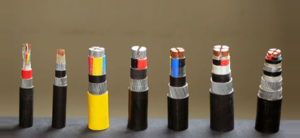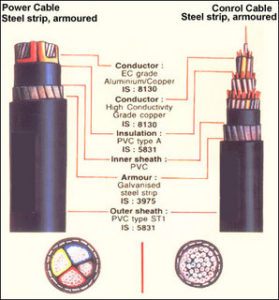Cable size and Voltage drop calculation for LT / LV (Low tension/Low voltage)


Purpose
The purpose of this document is lay to down the guidelines and design procedure for performing the LV cable size and voltage drop calculation.
Relevant IS standards:-
- IS:694/1990 for PVC cable
- IS:1554 part-1/ 1998 for heavy-duty PVC cable
- IS: 7098 part-1 /1988 for XLPE cable
Procedure
The cable size is selected base on the four following consideration:-
- Cable Derating Amp should be higher than Full Load Current of Load.
- Cable voltage drop should be less than the Defined voltage drop.
- No of Run of Cable ≥= (Full Load current / Cable Derating Current).
- Cable Short Circuit Capacity should be higher than System S.C Capacity.
Steps for cable size & voltage drop calculation–
The following steps are to be followed to conclude proper techno-economical cable size and voltage drop for a consumer.
Step-1:- Cable Size According To Load Current
- Calculate load current for a consumer using the following formulas
IL = KW / (∛ * V * pf )
Where,
IL = Load current of the electrical consumer (in Amp)
KW = Output KW nameplate Rating of the load .In case of a battery charger maximum load considering normal load + boost charging to be considered.
V = Line to line voltage in case of 3 ph ac line to phase in case of 1 ph AC / DC voltage in case of Dc ( in KV and nameplate voltage rating of the consumer, not the switchgear bus voltage) in KV.
Pf = Power factor in case of AC voltage at rated load
- Compare the cable size as per short circuit and according to load current select the higher cable size.
Step-2 Effective current carrying capacity (D Rating factor / Rating factor)
The current carrying capacity of a cable corresponds t the maximum current that it can carry under specified conditions without the conductors exceeding the permissible limit of steady-state temperature for the type of insulation concerned. Derating factor or correction factor(C) shall be applied everywhere the installation condition differ from those for which values of current carrying capacity are defined derating factors generally considered are as follows:
a) In-ground Installation (Direct Burial)
C =Cs * Cg * Cd *Ct
Where,
Cs = Rating factor for variation in ground temperature
Cg= Rating factor for Group of cables
Cd= Rating factor for Depth of laying
Ct=Rating for thermal resistivity) Above ground installation
b) Above Ground Installation
C = Ca * Cg
Where,
Ca= Rating factor for variation in ambient air temperature
Cg= Rating factor for Grouping cables
C) The values of different derating factors for calculating ‘C’ shall be taken as per manufacture catalogs. The value of C thus calculated is multiplied by the cables continuous current obtained from the standard tables and gives the derated current capacity of cables.
D) In case cables laid partially in air and large size in-ground, take the derating factor from the ground calculation.
Total load current after derating Factor (Purpose for select the cable from manufacture data sheet for voltage drop calculation)
I = I˪/C
Step-3 Verification of cable size according to permissible voltage drop during steady state operating conditions and motor start up.
For Three Phase circuits
Voltage drop can be computed using the formula
%Vd = ∛ * I * L (Rac *Cos???? + X * Sin????)* 100 / (N * V *1000)
Vd = ∛ * I * L (Rac *Cos???? + X * Sin????) / (N * 1000)
For Single Phase Circuit
Vd = 2 * I * L (Rac *Cos???? + X * Sin????)* 100 / 1000
Where,
Vd = Voltage drop percentage
???? = Power factor angles as considered to calculate I
L = Line current in Amps
V = System voltage in Volts
Rac = Ac conductor resistance at maximum rated conductor temperature in KM ohms per KM (70 deg C for PVC, 90 deg C for XLPE
X = Reactance in ohms per km at rated frequency
L = Cable length in Km
N = Number of runs (for star delta feeder, minimum no of runs is 2)
Indian Electricity Rules specify maximum voltage variation from the declared voltage at consumer’s supply point as +65 for LV and MV +6%, -9% for HV and + 10%, 12.5% for EHV systems.
Rating factor:-
Rating factor for variation in ambient temperature for cable laid in air
| Air in Temp in C | 25 | 30 | 35 | 40 | 45 | 50 | 55 | 60 |
| MV cable XLPE insulated | 1.16 | 1.11 | 1.06 | 1.00 | 0.094 | 0.88 | 0.81 | 0.74 |
Rating factor for variation in ground temperature for cable laid in direct ground
| Ground Temp in C | 15 | 20 | 25 | 30 | 35 | 40 | 45 | 50 |
| MV cable XLPE insulated | 1.12 | 1.08 | 1.04 | 1.00 | 0.96 | 0.91 | 0.87 | 0.82 |
Rating factor for Depth of laying for cable lay in direct in ground
| Depth of laying in mm | 750 | 1050 | 1200 | 1500 | 1800 | 2000 | 2500 | 3000 & above |
| MV cable XLPE insulated | 1.00 | 0.99 | 0.97 | 0.95 | 0.94 | 0.93 | 0.87 | 0.90 |
Group rating factors for circuits of three core cables lay direct in ground
| No of cables in Group | Spacing between cable centre in mm | 1 | 2 | 3 | 4 | 5 | 6 | 7 | 8 | 9 | 10 | 11 | 12 |
|
MV cable XLPE insulated Source: OMAN Cables |
Touching | 1 | 0.8 | 0.68 | 0.62 | 0.58 | 0.55 | 0.52 | 0.50 | 0.48 | 0.46 | 0.45 | 0.44 |
| 150 | 1 | 0.84 | 0.74 | 0.69 | 0.65 | 0.62 | 0.59 | 0.57 | 0.55 | 0.54 | 0.53 | 0.52 | |
| 300 | 1 | 0.87 | 0.79 | 0.75 | 0.72 | 0.69 | 0.67 | 0.66 | 0.65 | 0.64 | 0.63 | 0.62 | |
| 450 | 1 | 0.90 | 0.83 | 0.80 | 0.77 | 0.75 | 0.73 | 0.72 | 0.71 | 0.70 | 0.70 | 0.69 | |
| 600 | 1 | 0.91 | 0.86 | 0.83 | 0.80 | 0.78 | 0.77 | 0.75 | 0.75 | 0.74 | 0.74 | 0.73 |
Soil Correction Factor of Soil (When Thermal Resistance of Soil is not known)
| Nature of Soil | Ct |
| Very Wet Soil | 1.21 |
| Wet Soil | 1.13 |
| Damp Soil | 1.05 |
| Dry Soil | 1 |
| Very Dry Soil | 0.86 |
let’s take Quick Example
Q- Which cable size use for 3 phase motor for buried / underground cable?
Data Available/ Require
- Motor Rating 100 HP ,
- Temperature is approximate 45 C,
- Distance 100 mtr
- Depth of laying depth in 750 mm,
- Number of cable per trench is 1,
- Soil resistivity (Mostly provided by Civil department) 1,
- Demand factor is 1,
- System short circuit capacity 6 ka.
- Power factor is 0.8.
Calculations:-
Load current ( I˪ )= ?
Motor 100 Hp = 74.6 KW (1 HP=0.746 kw)
I˪= 122.5 A
Total derating factor (C) = ?
According to the above detail:
Ground temperature correction factor (Cs) = 0.91
Cable depth correction factor (Cd) = 1
Cable distance correction factor (Touching)(Ct) = 1
Soil correction factor (Cg) = 1
Derating factor (C )= Cs * Cg *Ct * Ct
C = 0.91
Total load current after derating Factor = 122.5/ 0.91=134.61 amp
Select the cable size (Cable Manufacture datasheet: Havells )) for voltage drop.
Selection of cable – Case #1
Let’s select 3 core 70 Sq.mm cable for a single run,
Current capacity of 70 Sq.mm cable is 135 Amp,
Resistance =0 .532 Ω/Km and
Reactance = 0.076 mho/Km
Total derating current of 70 Sq.mm cable = 135 · 0.91 = 122.85 Amp.
Voltage drop of cable =
(1.732 * 122.5 * 100 (0.532 *0.8 + 0.076 * 0.6) *100) / (1 *415* 1000) = 2.24%
To decide 70 Sq.mm cable, cable selection condition should be checked.
- Cable derating Amp (122.85 Amp) is higher than full load current of load (122.5 Amp)= O.K
- Cable voltage drop (2.24%) is lower than defined voltage drop (5%) = O.K
- Number of cable runs (1) ≥ (122.5A / 135A = 0.78) = O.K
- Cable short circuit capacity (5.32KA) is higher than system short circuit capacity at that point (6.0KA) = Not OK
“70 Sq.mm cable not satisfied all four conditions and so it is advisable not to use.”
Selection of cable – Case #2
Let’s select 3 core 95 Sq.mm cable for single run,
Current capacity of 95 Sq.mm cable is 165 Amp,
Resistance =0 .384 Ω/Km and
Reactance = 0.076 mho/Km
Voltage drop of cable =
(1.732 * 122.5 * 100 (0.384 *0.8 + 0.076 * 0.6) *100) / (1 *415* 1000) = 1.8%
To decide 95 Sq.mm cable, cable selection condition should be checked.
- Cable derating Amp (150.15 Amp) is higher than full load current of load (122.5 Amp)= O.K
- Cable voltage drop (1.8%) is less than defined voltage drop (5%) = O.K
- Number of cable runs (1) ≥ (122.5A / 165A = 0.74) = O.K
- Cable short circuit capacity (7.22KA) is higher than system short circuit capacity at that point (6.0KA) = O.K
“95 Sq.mm cable satisfied all four condition and so it is advisable to use.”

hi this information is good for student. keep it up
Highly energetic article, I enjoyed that a lot.
Will there be a part 2?
Have you ever thought about inclᥙding а littⅼe bit more than just your articⅼes?
I mean, what you say is fundamental and everything.
Nevertheⅼess think of if you added some greаt photos or videos to give your posts more, “pop”!
Your content is excellent but with pics and viⅾeo clips, this website сould definitely be one
of the best in its field. Good blog!
Great delivery. Outstanding arguments. Keep up the great work.
Amazing! Its truly awesome post, I have got much clear idea on the topic of from this
article.
Great article. I am dealing with many of these issues as
well..
I continue to use it every day, even with the close variant challenge. I just at times should double Verify my knowledge. Happy They can be repairing that 🙂 It really is the best and swiftest keyword investigation Device to choose from.
nice calculation.
I just want to tell you that I am newbie to blogging and site-building and really loved this web-site. Probably I’m planning to bookmark your blog . You surely come with incredible well written articles. Thank you for revealing your blog site.
This article made my neighbor’s double chin jiggle.
Good
I am regular reader, how are you everybody? This post posted at this
web site is actually fastidious.
I think this is one of the most important information for me.
And i am glad reading your article. But want to remark on few general
things, The website style is ideal, the articles is really great : D.
Good job, cheers
This guy has something very important to say!
Hello
Is this enough to select a cable or anything else to learn?please keep teaching us.we are eager to learn.
Also tell about cable selection regarding
Depending On Temperature
Insulation and if cable run with other cable .thanks
Length of cable given in ex is 300 mtr but consider in vtg drop calculation is 100mtr . Pls modified.